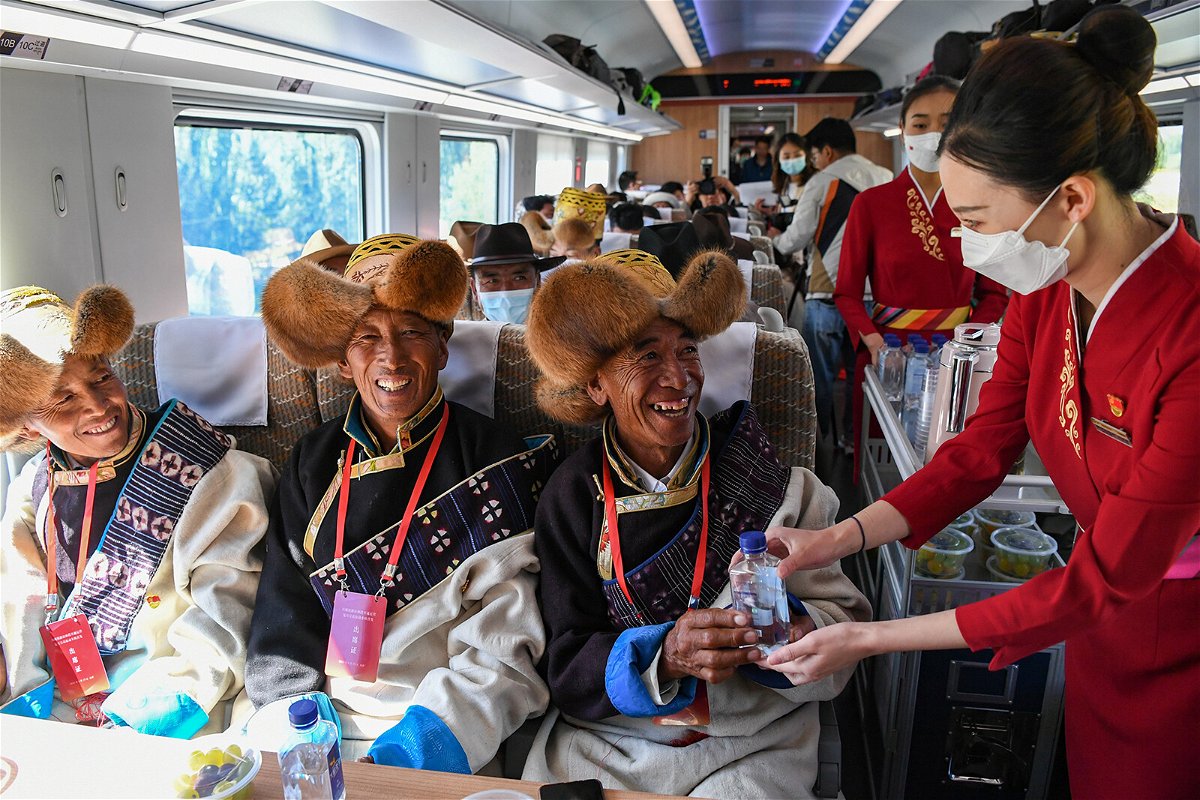Tibet’s first bullet train line enters service

With the opening of Lhasa-Nyingchi Railway in Tibet
By Maggie Hiufu Wong, CNN
For the first time, travelers in Tibet can enjoy the area’s mountainous views at high-speed.
A 435-kilometer (250-mile) rail line connecting Tibetan capital Lhasa with the city of Nyingchi entered into service on June 25, giving all 31 provincial-level regions of mainland China access to high-speed train travel.
47 tunnels, 121 bridges
Building a high-speed railroad in Tibet, dubbed the “roof of the world,” was no easy feat.
Some 90% of the route, which took six years to construct, sits higher than 3,000 meters above sea level.
The Lhasa-Nyingchi line features 47 tunnels and 121 bridges — which account for about 75% of the whole route. This includes the 525-meter-long Zangmu Railway Bridge, the largest and highest arch bridge of its kind in the world.
A staggering RMB 36.6 billion ($5.6 billion) was spent to build the line, which is serviced by the Fuxing series of high-speed electric trains developed and operated by the state-owned China State Railway Group.
Traveling at high altitudes, the Fuxing trains are equipped with automated oxygen supply systems, which keep oxygen levels at a constant 23.6% — slightly higher than the 21% average found in normal atmospheres.
The trains’ windows are equipped with a special layer of glass designed to withstand the region’s high UV levels.
The Fuxing trains deployed on the nine-station Lhasa-Nyingchi line are powered by both internal combustion and electric engines. The dual-power engine allows them to achieve smooth traction throughout the 2.5-hour journey on both electrified and non-electrified railroads.
They operate at about 160 kilometers per hour — far slower than the maximum speeds of 350 kph (217 mph) travelers experience on many of China’s other lines.
Sichuan-Tibet Railway now a third complete
The new Lhasa-Nyingchi route is part of the Sichuan-Tibet Railway, a 1,740-kilometer line that will eventually link Chengdu, the capital of Sichuan province, with Lhasa, shortening the travel time between the two cities from 48 hours to 13 hours.
Construction has been divided into three phases. The first segment — the Chengdu-Ya’an Railway — opened in 2018. Lhasa-Nyingchi is the second completed segment. Work on the final Ya’an-Nyingchi Railway began in 2020 and is expected to be complete by 2030.
The Lhasa-Nyingchi line is Tibet’s first electrified railway. The existing Qinghai-Tibet Railway, a 1,142-kilometer route powered by diesel locomotives, launched in 2006 and is said to be the world’s highest train route, connecting Xining, in Qinghai province, to Lhasa.
Flexing China’s economic power
Stretching into a disputed area between India and China, the Lhasa-Nyingchi Railway is just a small part of China’s rapidly-expanding high-speed network.
Close to 40,000 kilometers of lines crisscross the country, linking all of China’s major mega-city clusters. The network is expected to expand to 70,000 kilometers by 2035.
Much like Japan’s Shinkansen bullet trains in the 1960s, the Beijing government views its high-speed railway as symbolic of the country’s economic power and increasing prosperity.
For China’s ruling Communist Party and its leader Xi Jinping, high-speed rail is also a powerful tool for social cohesion, political influence and the integration of disparate regions with distinct cultures into the mainstream.
“The building of these new railways forms part of Xi Jinping’s grand plan of ‘integrating the vast national market,'” Olivia Cheung, research fellow at the China Institute of the University of London’s School of Oriental and African Studies (SOAS), told CNN in an interview earlier this year.
“It is also meant to be reflective of his ‘new development philosophy,’ of which ‘coordinated development’ is a key concept.
“His scheme is grand in that it extends beyond just simply connecting existing towns, but existing towns with new mega-towns that are being constructed from scratch. A famous example in which Xi takes a lot of pride is the Xiong’an New Area in Hebei province, around 60 miles southwest of Beijing.”
The-CNN-Wire
™ & © 2021 Cable News Network, Inc., a WarnerMedia Company. All rights reserved.
Ben Jones and Shawn Deng also contributed to the report.